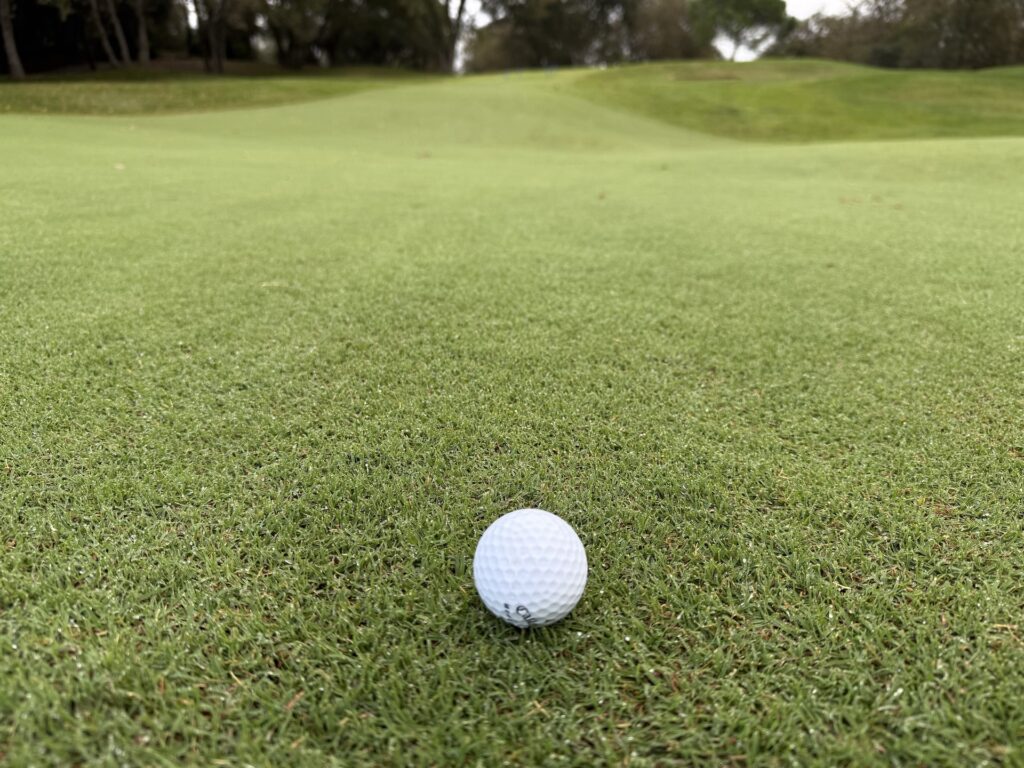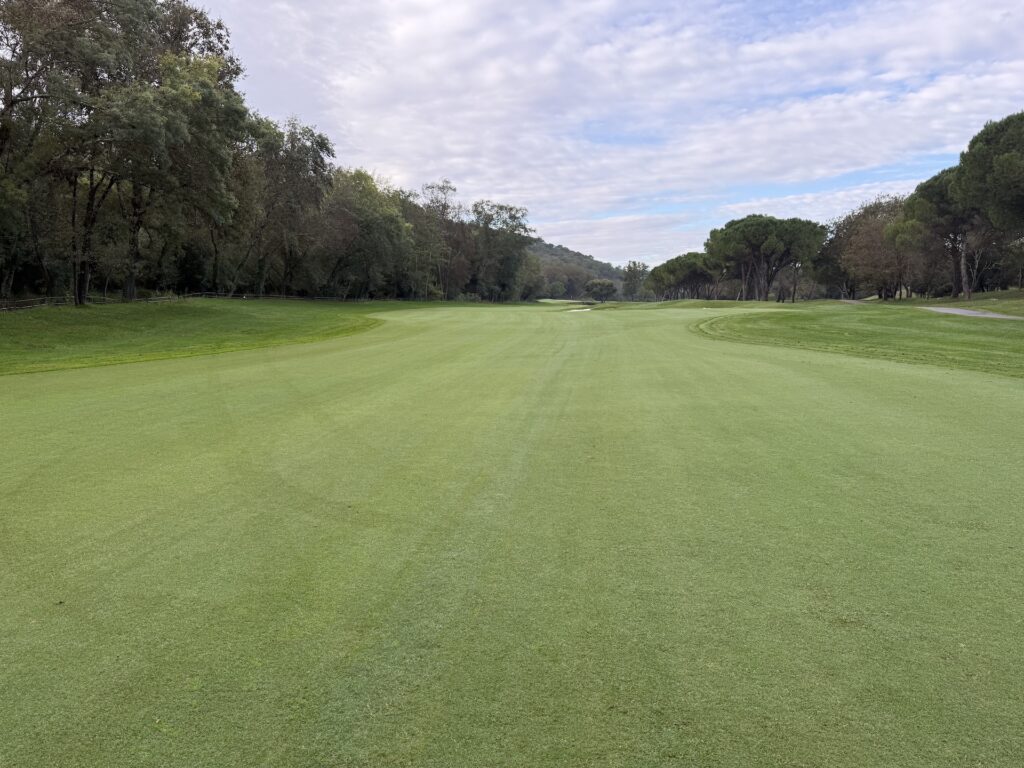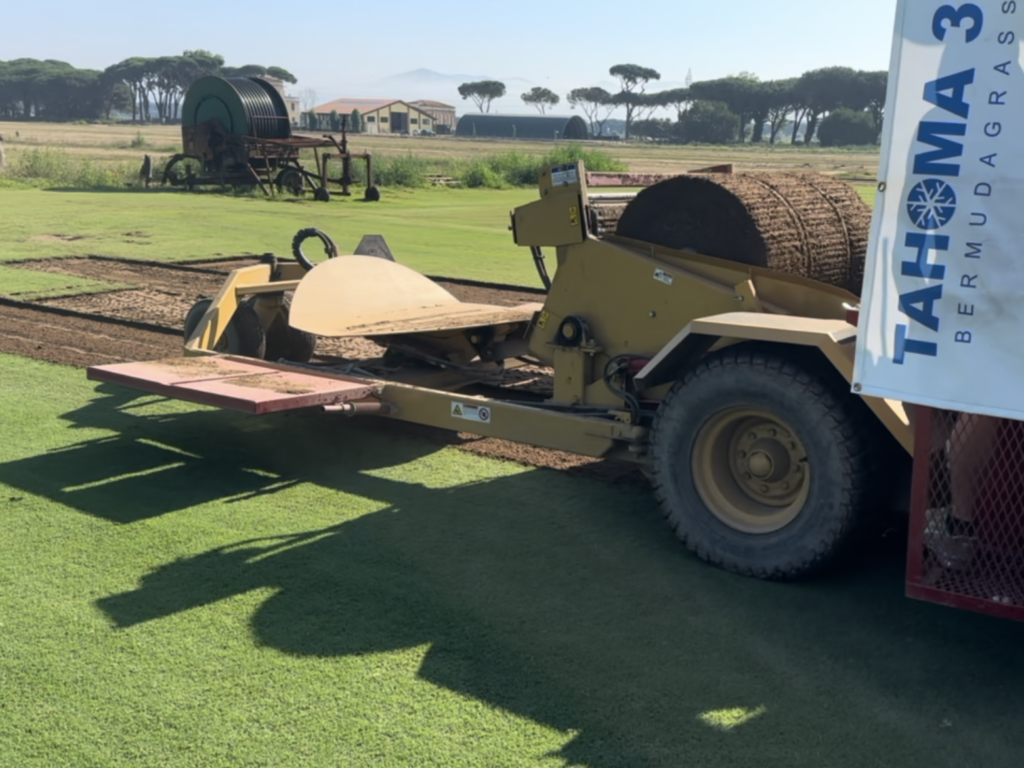About the Project
Opened in 1923, Cannes Mougins is one of the most prestigious courses in France. From 1984 to 1994 and again in 2001, the club hosted the Cannes Open, boasting wins from the likes of Seve Ballesteros, Mark McNulty, and Ian Woosnam. In the summer of 2024, the course was closed for two months, and all 18 fairways were renovated from cool-season grass to Tahoma 31 bermudagrass.
Spearheaded by Alejandro Reyes, director of agronomy for the consultancy firm Turfgrass Agronomy Services based in Spain, T.A.S. works in 27 countries around the world for more than 100 clients. The grow-in at Cannes Mougins was facilitated by Golf Course Superintendent Thibaut Perez. The grass was grown by Marco Bindi and his team at Bindi PratoPronto nord s.s. , a licensed sod producer, who harvested the Tahoma 31 at a farm near Rome, Italy. Bindi’s staff shipped the grass as Big Roll sod and, using a Sprigmaster, installed it on-site using the sod-to-sprigs process.
Reyes says 20 years ago, when he was still an agronomy student, the idea of grassing a course as far north as Cannes Mougins (located at latitude 43 in the transition zone) “was impossible.” He credits the “new generation” of grasses such as Tahoma 31, whose cold tolerance pushes the boundaries of where bermudagrass can thrive.
Before committing to the renovation, Reyes tested a few square meters of Tahoma 31 against Tifway 419, Common Bermuda, and a seashore paspalum variety on-site at Cannes Mougins, then expanded to a full fairway. Once Tahoma 31 proved itself as the best performer, the club membership approved the fairway regrassing. The course also has some areas of Tahoma 31 in the driving range, and rough.
PROJECT DETAILS
Facility:
Golf de Cannes Mougins
Date:
July 2024
Location:
Cannes, France
Sod Producer:
Bindi PratoPronto Nord (Rome, Italy)
Fun Facts:
The Riviera’s first golf course to convert from cool-season grass to Tahoma 31
Where Planted:
Fairways
Benefits of Density
Perez and Reyes agree that selecting a turf with a dense canopy was imperative to address two issues on the golf course—herbicide restrictions and playability.
“We have very little selective herbicide to use in France, and our intention is to reduce the use of herbicides as much as possible while keeping high playability,” Reyes says. Not having access to herbicides to eradicate grassy weeds such as poa annua “is very difficult.” Instead, Reyes prioritized selecting a very dense turf, such as Tahoma 31, that could help choke out weeds.
Perez adds: “We like the density because goosegrass, paspalum, and crabgrass are problematic, and we currently have no effective selective way to control them. We needed something to conquer and push these weeds out of play naturally, while controlling them mechanically.”
In addition, a dense turf that tolerates a lower height of cut increases playability and ball roll. The Tahoma 31 fairways are maintained at 9mm (.35-inches) as compared to 14mm (.55-inches) on the cool-season grass, which is significant.
“Tahoma 31 on fairways can allow us to cut the fairways much shorter during the season,” Reyes says. Comparatively, the cool-season grasses that were in the fairways suffered in the heat of summer, “and we don’t have enough water to irrigate, so it was very challenging.”
“It makes the fairways faster, firmer at the end of the day as well because we have less material and the ball is going to roll longer on the drive so it could make the golf course a little bit shorter … but that’s something that the members say they are very happy about. Also, we shouldn’t forget that we don’t need to irrigate as much as the cool-season grass. So again, it’s drier, it’s firmer during the season, so the members just love it because it’s improving the playability of the golf course,” Reyes says.
Low Water Use, Low Water Quality
“Right now in France, almost every year we have water restrictions during the summer period,” says Perez. “Sometimes, at the end of August and September, we only have authorization to water the greens.”
Planting a grass like Tahoma 31 that could survive with little to no irrigation in the summer heat and hold on until water was again available for irrigation was critical to the project’s success. Reyes added that the club is considering eventually changing over to reclaimed water as its irrigation source. As bermudagrasses, in general, can handle some amount of salt and poor water quality, the selection made sense.
Disease Resistance
Along with herbicides, fungicide use is severely restricted in France. “None of our customers in France spray fairways for several reasons: the cost, the need to close the golf course and the trend to reduce the use of phytosanitary products,” Reyes says. “Compared with Tifway 419, the amount of Spring Dead Spot that we are going to get on the Tahoma 31, in my experience, is like 10 times less. Actually, we didn’t see any Spring Dead Spot on our first fairway that we tested. Compared to the old cool-season fairways, we are not suffering anymore from Dollar Spot or Anthracnose.”
Spring Green-Up
This past winter, Perez says his crew overseeded fairways to keep the grass green through the winter months. But, as the region has so few herbicide options, transitioning out of overseed had to be done mechanically, not chemically. This was just one more reason Tahoma 31 was the right choice for Cannes Mougins, he says. Research shows that the grass is the last to go into fall dormancy and the first to green up in the spring. Perez confirmed that by mid-March, the Tahoma 31 grass at Cannes Mougins was already breaking dormancy and starting to push out the overseed.
Quick Grow-In
As Bindi recalls, his crew installed the Tahoma 31 sprigs on the fairways at Cannes Mougins between July 1 – July 4, 2024. Sixty days later, in September, the course opened for play. Reyes says the facility went from mud to a fully-playable golf course in four weeks, which is practically unheard of. To deliver the highest quality fairways for the membership, the course remained closed for a full 60 days. Reyes and Perez say the member’s reaction was nothing short of astounded.
“I mean nobody, nobody, nobody believed it that in 60 days it was perfectly playable. And it was better than when we closed the fairways,” Reyes says.
Perez seconds that. “Yeah, 100 percent. They were really shocked. For the members who visited during the construction, it was like ‘It’s impossible. You’re not going to open in two months.’ The bermudagrass grows really fast, and it was really stunning at the opening.”








